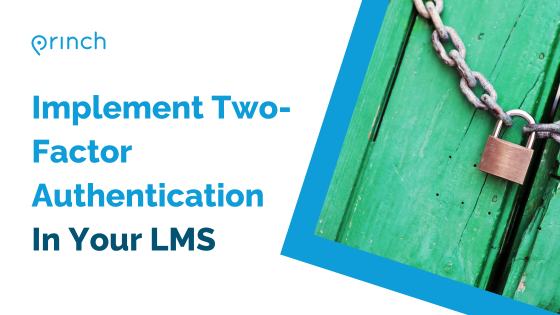In this week’s Princh Library Blog, recurring guest writer Nina Grant discusses why your library should implement two-factor authentication for your library management system (LMS), and the various benefits doing so will bring. Enjoy!
Keeping your library’s data safe is more important than ever these days. Just like your personal accounts, library databases hold information, from patrons’ personal details to an extensive catalogue of resources. Without robust security measures, this data is vulnerable to breaches. That’s where Two-Factor Authentication (2FA) comes in. When you add an extra layer of security, 2FA helps protect against unauthorized access and makes your library management system much more secure.
Understanding Two-Factor Authentication
Two-Factor Authentication is a security measure that requires two forms of identification before granting access. It’s like having two locks on your front door—one is your regular key (a password), and the other could be something you have (like a mobile phone to receive a verification code) or something you are (like a fingerprint). This dual-layer approach significantly reduces the risk of unauthorized access. Even if someone gets hold of your password, they will still need that second piece of information to access the system.
Here are some eye-opening stats to show how effective 2FA can be:
- Cut Down Data Breaches: Multi-layered security (like 2FA) can slash data breaches by up to 50%, according to IBM.
- Speed Up Response Time: Companies using multi-layer security detect and respond to security issues 27% faster than those with just single-layer protection, says the Ponemon Institute.
- Reduce Phishing Attacks: Combining password protection with things like biometric verification can reduce phishing risks by around 90%, as Google reports.
- Meet Compliance Needs: Businesses with dual-layer security are 30% more likely to meet regulatory compliance requirements, which also helps avoid fines for data breaches, according to Cybersecurity Ventures.
- Protect Against Insider Threats: Using both physical and digital access controls can cut the risk of insider threats by 40%, based on a survey by the SANS Institute.
Learn the key aspects of Princh! Watch our on-demand demos at your convenience and see what makes Princh such a simple solution. Watch our demos here.
How to Set Up Two-Factor Authentication
First, you’ll need to choose a 2FA method that works best for your library. Popular options include receiving a code via SMS, using an authentication app, or biometric verification like fingerprints. Once you’ve chosen your preferred method, most library management systems will guide you through the setup process. Typically, this involves linking your phone number or app with your account so that a code gets sent to you whenever you try to log in. Yes, it might take an extra few seconds to access your account, but that small effort can make a world of difference in keeping your data secure.
Why Train Library Staff Properly?
Training library staff on 2FA is crucial for several practical reasons. First off, it means that everyone knows how to set up and use 2FA with ease, which minimizes any hiccups and keeps the system running efficiently. When staff are well-trained, they understand the importance of this extra security layer and are more likely to follow through, making the library’s data much safer. When they’re equipped with this knowledge, they can also help patrons who might struggle with the new system. Plus, well-informed staff can spot and address potential security issues more quickly, adding another layer of defence.
Specific Benefits for Libraries
First and foremost, it heightens security and makes unauthorized access almost impossible. This not only protects sensitive data but also boosts trust among patrons. People will feel more comfortable knowing their personal information is well-guarded. Secondly, 2FA can help you stay compliant with various data protection regulations, which is a big plus. Lastly, on a practical level, it reduces the chances of system downtime caused by security breaches. The peace of mind that comes from knowing your system is secure? That’s priceless.
When you say yes to 2FA, you’re actively protecting your valuable data and enhancing the user experience for your patrons. So, don’t wait. Take that crucial step today and add an invaluable layer of security to your library system.
We will be back with another interesting article from the library world soon!
Want more insights from libraries across the world?
Subscribe to our blog to receive new library insights directly to your e-mail.
Nina Grant
Nina is a passionate writer and editor who likes to cover a variety of topics.
Recent posts
Enhancing User Experience For Libraries In The Digital Age
In this week's Princh Library Blog post, recurring guest writer Sam L. Bowman covers how your library can improve the user experience on [...]
Library Password Practices—Balancing Accessibility and Security
In this week's Princh Library Blog, recurring guest writer Nina Grant discusses a basic, but nevertheless crucial digital security principle: secure password [...]
Green Libraries: How Sustainable Design is Shaping the Future of Public Libraries
In this week's Princh Library Blog post, recurring guest writer Sam L. Bowman discusses an ever so important topic: sustainable design and [...]


